|
Yoga is perhaps the most important component of off-ice training for a well-balanced figure skater. This is not to say that mental training, conditioning, plyometrics, nutrition, off-ice spinning, and off-ice jump training are not important. It’s all important! And as skating folks–coaches, parents, and skaters–we have to juggle our time, money, and energies, based on all the factors and realities of our current situation. What’s right for one moment or goal, may not be a top priority for another moment. Of all the off-ice training a skater might do, though, yoga is the most well-rounded, holistic, all-encompassing piece. Yoga, when taught well, is about slowing down to cultivate awareness and self-knowledge. Yoga is the off-ice training that helps skaters assimilate all the other aspects of training, while also helping them develop an inner confidence, calm, and love that will help them withstand the chaos and frenetic pace of a highly competitive sport and world. The framework I use to teach yoga to figure skaters is based on Patanjali’s 8 limbs of yoga. This means that I teach positive mindset and training habits, philosophy, breathwork, focus, and concentration, as well as physical postures. Because while yoga is not really about developing a deeper backbend or touching your toes (even though these things often happen), it is very true that most skaters find it easiest to begin studying yoga through movement and asana (physical postures). It’s what they’re used to and what makes the most sense to them! So, I’ve compiled my favorite asanas for figure skaters to use as a starting point for their yoga practice. These asanas all have strong applications to movements or positions on the ice, so they should be familiar to most skating folks. This is the last installment of a 3-part series teaching a comprehensive list of my top picks of yoga poses (asanas) for figure skaters. To learn about the other asanas, visit here for Part I and here for Part II. Learn to Land Jumps with Eagle Pose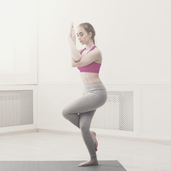 Eagle Pose - Garudasana Eagle Pose - Garudasana Eagle pose is, in my opinion, the most important asana for jumping. The intention of the pose is alignment and stability, rather than flashiness. It mimics the moment of impact with crossed legs and a bent standing knee, and when regularly practiced with intention, can develop muscle memory for this crucial position. The glutes squeeze towards each other in the back while the inner thighs, shins, and arms are doing the same in the front body. The standing leg roots into the mat, while the elbows and torso rise up tall–just like the “third UP” of a jump. And when practiced on the mat, you can really notice the feet working to maintain stability. The instructions below are how I usually teach Eagle with traditional yoga instructions.
Relieve the IT Band with Parsvottonasana - Intense Side Stretch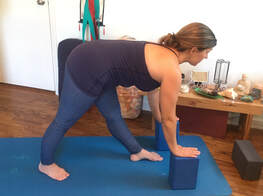 Practicing Parsvottonasana - Intense Side Body Stretch - with blocks Practicing Parsvottonasana - Intense Side Body Stretch - with blocks What skater doesn’t have a chronically tight IT Band? The IT Band, or iliotibial band is an important and very strong piece of connective tissue that runs from the hip along the outer thigh and attaches to the upper part of the tibia (shin bone). Because it acts as a stabilizer to keep the bones in correct alignment, and good skating is all about alignment, it’s easy to overuse the IT Band. When it gets too tight, the IT Band can cause knee pain (patellofemoral syndrome), hip bursitis, and lower back issues. A great pose for gently stretching the IT band is Parsvottonasana, or Intense Side Body Stretch, and also sometimes called “pyramid” pose. Here’s how to do it:
Super Figure Skating with "Superman" Salabhasana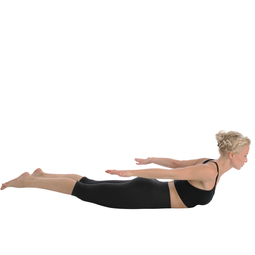 Locust Pose is a must-do for strengthening the back side of the body (aka the posterior chain). It is also good for the digestive system and the abdominal muscles. To try it:
For a Better Layback Spin, Do Camel Pose - Ustrasana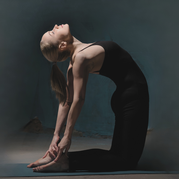 Camel pose is one of the poses I hated for the first few years I tried it. With chronically tight quadriceps and hip flexors, even standing on my knees without trying to do the backbend here was daunting. Now, though, I love Ustrasana. It’s still a big challenge, but I’ve found how to make it work for me and my body. Ustrasana stretches and tones the spine and the entire front of the body, and coming out of the backbend works the abdominals. To try Ustrasana:
How to Safely Touch Your Toes with Paschimottonasana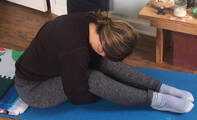 A good hamstring stretch is important for skaters, and for many, is often considered a measure of flexibility (albeit an imperfect one). Paschimottanasana, seated forward fold, is a great pose that can be safely practiced by most everyone with a few precautions. Here’s how to do it:
Get Better at Stroking with Utkatasana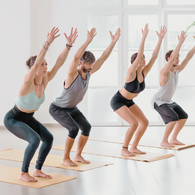 A Yoga Class Practicing Utaktasana - Fierce Pose A Yoga Class Practicing Utaktasana - Fierce Pose Utkatasana is a strength builder – it strengthens the abdominal muscles, lower back, glutes, quadriceps, ankles, and diaphragm, but really, activates the entire body. It opens the chest, stretches under the arms, and develops mobility in the shoulders. B.K.S. Iyengar said in Light on Yoga that this “is a beneficial pose for horsemen”... a side note that seems outdated, but is very accurate. As skaters, we must maintain strong legs and deep ankle and knee bend while demonstrating upright, undisturbed carriage. It’s all about staying grounded into the ice, while the upper body is free to move about, interpreting the music and looking both fierce and elegant. To practice:
Off-Ice Figure Skating Training with YogaThe purpose of all yoga is to build awareness and help allow the mind to slow down, so we can begin to follow our own path of purpose, happiness, and fulfillment. And while yoga involves many different things besides just physical postures, an asana practice is a good starting point for the yoga journey. There are so many great poses, but the ones outlined in this post and in the other two parts of this series are my top picks (the most effective) for skaters. These poses offer direct parallels to skating postures, and most of them do not require any props to practice safely, so you can try them anywhere, anytime. All you need is to find a good spot with enough space and light, where you won’t be worried about anything but your breath. Do a gentle warm-up to get the blood flowing through the muscles, and then pick as many of the poses as you have time for. Only have 5-10 minutes? Do a quick warm-up and do 1-2 poses. Have more time? Do a couple more poses. Just try to leave yourself enough time to end with a short relaxation in Savasana or Viparita Karani. The relaxation after the asana is where the magic happens. Get practical yoga tools for handling the monkey mind that pops up at performance mind with my FREE GUIDE: Anti-Anxiety Tools for Skaters.
0 Comments
Leave a Reply. |
Author // the skating yogiMy name is Sarah Neal. I have been immersed in the world of figure skating for over four decades. I have seen firsthand the abuse that happens at the higher levels of our sport and experienced how that trickles down into unhealthy training practices and habits at the grassroots. I have seen this play out in the operations of the very institutions that control our sport. Whether for a profession or hobby, pursuing skating should be a joyful, rewarding process, an opportunity for athletic and personal growth, and a place to build lasting friendships. Archives
March 2024
CategoriesAll Athlete Well Being Athlete Well-Being Deep Connections Embodied Movement And Meditation Practices Life After Competition Mindful Living |
Search by typing & pressing enter

 RSS Feed
RSS Feed